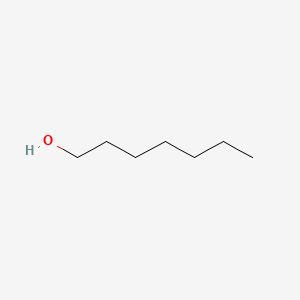| MeSH term | MeSH ID | Detail |
|---|---|---|
| Tachycardia, Ectopic Atrial | D013612 | 1 associated lipids |
| Wounds, Gunshot | D014948 | 2 associated lipids |
| Heart Injuries | D006335 | 6 associated lipids |
| Tachycardia, Ventricular | D017180 | 9 associated lipids |
| Radiation Injuries, Experimental | D011833 | 11 associated lipids |
| Eye Burns | D005126 | 13 associated lipids |
| Cardiomegaly | D006332 | 31 associated lipids |
| Hypertension, Pulmonary | D006976 | 32 associated lipids |
| Ventricular Dysfunction, Left | D018487 | 33 associated lipids |
| Neovascularization, Pathologic | D009389 | 39 associated lipids |
| Arrhythmias, Cardiac | D001145 | 42 associated lipids |
| Occupational Diseases | D009784 | 42 associated lipids |
| Reperfusion Injury | D015427 | 65 associated lipids |
| Diabetes Mellitus, Experimental | D003921 | 85 associated lipids |
| Hypertension | D006973 | 115 associated lipids |
| Adenocarcinoma | D000230 | 166 associated lipids |
n-heptanol
N-heptanol is a lipid of Fatty Acyls (FA) class. N-heptanol is associated with abnormalities such as Corneal Neovascularization. N-heptanol often locates in Epithelium and Structure of corneal epithelium. The related lipids are Heptanol.
Cross Reference
Introduction
To understand associated biological information of n-heptanol, we collected biological information of abnormalities, associated pathways, cellular/molecular locations, biological functions, related genes/proteins, lipids and common seen animal/experimental models with organized paragraphs from literatures.
What diseases are associated with n-heptanol?
n-heptanol is suspected in Corneal Neovascularization and other diseases in descending order of the highest number of associated sentences.
Related references are mostly published in these journals:
| Disease | Cross reference | Weighted score | Related literature |
|---|
Possible diseases from mapped MeSH terms on references
We collected disease MeSH terms mapped to the references associated with n-heptanol
PubChem Associated disorders and diseases
What pathways are associated with n-heptanol
There are no associated biomedical information in the current reference collection.
PubChem Biomolecular Interactions and Pathways
Link to PubChem Biomolecular Interactions and PathwaysWhat cellular locations are associated with n-heptanol?
Visualization in cellular structure
Associated locations are in red color. Not associated locations are in black.
Related references are published most in these journals:
| Location | Cross reference | Weighted score | Related literatures |
|---|
What functions are associated with n-heptanol?
There are no associated biomedical information in the current reference collection.
What lipids are associated with n-heptanol?
Related references are published most in these journals:
| Lipid concept | Cross reference | Weighted score | Related literatures |
|---|
What genes are associated with n-heptanol?
There are no associated biomedical information in the current reference collection.
What common seen animal models are associated with n-heptanol?
There are no associated biomedical information in the current reference collection.
NCBI Entrez Crosslinks
All references with n-heptanol
Download all related citations| Authors | Title | Published | Journal | PubMed Link |
|---|---|---|---|---|
| Gussler JR et al. | Collagen shield delivery of trifluorothymidine. | 1990 | J Cataract Refract Surg | pmid:2124262 |
| Li M et al. | Interaction of heptanol and pressure on sodium and chloride transport by toad skin. | 1990 | J. Appl. Physiol. | pmid:2125598 |
| Meda P et al. | Rapid and reversible secretion changes during uncoupling of rat insulin-producing cells. | 1990 | J. Clin. Invest. | pmid:1697604 |
| Spear JF et al. | Effect of cellular uncoupling by heptanol on conduction in infarcted myocardium. | 1990 | Circ. Res. | pmid:2295139 |
| Murrell RD et al. | Actions of n-alcohols on nicotinic acetylcholine receptor channels in cultured rat myotubes. | 1991 | J. Physiol. (Lond.) | pmid:1890643 |
| Peracchia C | Effects of the anesthetics heptanol, halothane and isoflurane on gap junction conductance in crayfish septate axons: a calcium- and hydrogen-independent phenomenon potentiated by caffeine and theophylline, and inhibited by 4-aminopyridine. | 1991 | J. Membr. Biol. | pmid:2051474 |
| Berta A et al. | Tear plasminogen activators--indicators of epithelial cell destruction. The effect of scraping, n-heptanol debridement, and alkali burn of the cornea on the plasminogen activator activity of rabbit tears. | 1991 | Int Ophthalmol | pmid:1778666 |
| Sandvig KU et al. | Regeneration of the rat corneal epithelium after injury. A cell kinetic study comparing the reaction after abrasions made mechanically and with n-heptanol. | 1991 | Acta Ophthalmol (Copenh) | pmid:1789085 |
| Serio R et al. | Slow-wave activity in colon: role of network of submucosal interstitial cells of Cajal. | 1991 | Am. J. Physiol. | pmid:1708208 |
| Christ GJ et al. | Intercellular communication through gap junctions: a potential role in pharmacomechanical coupling and syncytial tissue contraction in vascular smooth muscle isolated from the human corpus cavernosum. | 1991 | Life Sci. | pmid:1943478 |
